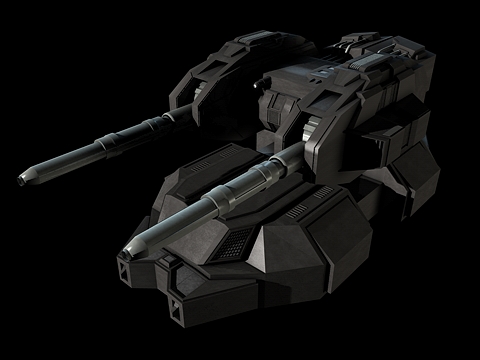Well-Known Member

OUT OF CHARACTER INFORMATION
Intent: To sub a new turbolaser turret for the CIS for future submissions and roleplaying.
Image Source: [X]
Canon Link: N/A
Primary Source: N/A
PRODUCTION INFORMATION
Manufacturer: Visanj T’shkali / Confederacy of Independent Systems
Affiliation: Closed-Market / CIS
Model: CIS-LTL-38 “Little 38” Light Turbolaser Turret
Modularity: Yes; can be mounted on various turret mounts.
Production: Minor
Material: Segroth Bantam, Turbolaser Components, Electronics Components
TECHNICAL SPECIFICATIONS
Classification: Dual Turbolaser Turret
Size: Large
Weight: Average
Ammunition Type: Powered by ship's reactor.
Ammunition Capacity: Limited only by ship's reactor output.
Reload Speed: Average
Effective Range: Battlefield
Rate of Fire: Very High
Stopping Power: Low
Recoil: None
SPECIAL FEATURES
- Experimental cooling system allows for the turret to fire incredibly rapidly without overheating or overtaxing the system.
- Specially-designed servo-turret offers terrific 360-degree movement and 45-degree up-and down movement, significantly offering a large field of fire range.
- Dedicated targeting system and automated remote operation can be controlled by a single computer or gunner, enabling banks of these weapons to be linked together on larger ships to maximize effectiveness.
- Armor is resilient against most lasers and similar energy weapons, though more vulnerable to heavier attacks.
- Can track and destroy incoming threats quickly and efficiently.
- With its rapid rate of fire and dedicated tracking / targeting computer, the “Little 38” is an excellent means of defense against starfighters and other small craft, able to make up for its lackluster stopping power by hitting them with a relentless barrage of rounds.
- Dedicated targeting computer tracks, analyzes, and prioritizes targets based on proximity, speed, and threat level, meaning that it will go for a missile first, then follow onto the fighter that launched it, continuing this process until a ‘clear sky status’ has been achieved.
- Fully automated, it requires no crew or dedicated gunner(s) to operate it, making it an ideal placement on ships where space is at a premium.
- Excellent point defense weapons on larger vessels, able to not only destroy small craft but incoming missiles and similar weapons.
- Relatively low stopping power as turbolasers go, which was a necessary trade-off for the cooling system to handle.
- Cannot be upgraded in terms of power without burning out the cooling system.
- Automated operation and tracking is vulnerable to EMP/Ion blasts.
- Cannot be mounted on vessels less than 20m in length.
- Cannot be fired underwater.
- Light armoring means these turrets are more vulnerable to heavier enemy attacks.
- Sensor jamming or similar tech can disable or confuse the turret, causing it to heavily affect accuracy and targeting ability.
Using a special carbonite coolant system, the "Little 38s" are able to fire much faster than standard turbolasers, however they are not as powerful as their cousins. Equipped with remote-operated automated systems and a dedicated tracking / targeting system, they will lock on and fire until the nearest threat is destroyed, then moving to the next nearest, and so forth until a 'clear sky status' has been achieved, i.e. all threats are neutralized, making them perfect for countering swarming starfighters and missile attacks. Excellent point defenses on larger vessels, due to their smaller size, automated systems, and firing capabilities. If mounted on ground vehicles (which also must be 20m or larger) they provide excellent defense against light armored vehicles, drones, and incoming rocket attacks. They are not suited for marine environments, and while sealed for submersion, cannot fire when submerged themselves.
The experimental cooling system used in these turrets works to direct excess heat energy away from the turret to the ship’s internal systems, working to thermoelectric generators which in turn direct power capacitors to be later used to add various onboard systems. So in fact, excess heat energy is reclaimed, converted to electric power, and stored for later use, such as auxiliary power to shields, engines, or other systems where needed. If the capacitors should be full however, having reached their maximum capacity, there is a possibility the turrets might then – and only then – be in danger of overheating. However, since the guns are used during combat, the stored converted energy is often quickly expended during this same time, directed to augment shield power or to other weapons systems, meaning that the guns are rarely – if ever – in such danger of overheating.







